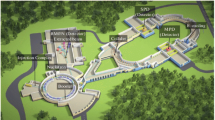Abstract
HADES is a versatile magnetic spectrometer aimed at studying dielectron production in pion, proton and heavy-ion-induced collisions. Its main features include a ring imaging gas Cherenkov detector for electron-hadron discrimination, a tracking system consisting of a set of 6 superconducting coils producing a toroidal field and drift chambers and a multiplicity and electron trigger array for additional electron-hadron discrimination and event characterization. A two-stage trigger system enhances events containing electrons. The physics program is focused on the investigation of hadron properties in nuclei and in the hot and dense hadronic matter. The detector system is characterized by an 85% azimuthal coverage over a polar angle interval from 18° to 85° , a single electron efficiency of 50% and a vector meson mass resolution of 2.5%. Identification of pions, kaons and protons is achieved combining time-of-flight and energy loss measurements over a large momentum range ( 0.1 < p < 1.0 GeV/c . This paper describes the main features and the performance of the detector system.
Similar content being viewed by others
References
R. Rapp, J. Wambach, Adv. Nucl. Phys. 25, 1 (2000).
R. Schicker, Nucl. Instrum. Methods A 380, 586 (1996).
V. Metag, Prog. Part. Nucl. Phys. 30, 75 (1993).
P. Salabura, Prog. Part. Nucl. Phys. 53, 49 (2004).
J. Friese, Prog. Part. Nucl. Phys. 42, 235 (1999).
A. Yegneswaran, Nucl. Instrum. Methods A 290, 61 (1990).
TOSCA part of OPERA 2D and 3D, Vector Fields, UK, www.vectorfields.com.
Linde Kryotechnik AG, Daettlikonerstrasse 5, PO-Box, CH-8422 Pfungen, Switzerland.
K. Zeitelhack, Nucl. Instrum. Methods A 433, 201 (1999).
J. Friese, Nucl. Instrum. Methods A 438, 86 (1999).
A. Kastenmüller, Nucl. Instrum. Methods A 433, 438 (1999).
J. Friese, Nucl. Instrum. Methods A 502, 241 (2003).
J. Friese, PEGASUS, the RICH gas system description and manual, internal note (2005).
J. Lehnert, Nucl. Instrum. Methods A 502, 261 (2003).
W. Beusch, Internal Note 4, CERN/ECP/MIP (1993).
J. Lehnert, Nucl. Instrum. Methods A 433, 268 (1999).
R. Dübgen, G. Popp, Z. Werkstofftech. 15, 331 (1984).
P. Maier-Komor, Nucl. Instrum. Methods A 438, 152 (1999).
P. Maier-Komor, Nucl. Instrum. Methods A 480, 65 (2002).
L. Fabbietti, Nucl. Instrum. Methods A 502, 256 (2003).
C. Garabatos, Nucl. Instrum. Methods A 412, 38 (1998).
H. Bokemeyer, Nucl. Instrum. Methods A 477, 397 (2002).
C. Müntz, Nucl. Instrum. Methods A 535, 242 (2004).
K. Kanaki, IEEE Trans. Nucl. Sci. 51, 939 (2004).
C. Lippmann, Aufbau und Inbetriebnahme eines Gasqualitätsmonitors für die HADES Driftkammern, Diploma Thesis (Johann Wolfgang Goethe-Universität Frankfurt, 2000).
E. Badura, Part. Nucl. Lett. 1, 73 (2000).
M. Newcomer, IEEE Trans. Nucl. Sci. 40, 630 (1993).
J. Markert, Proceedings of the XL International Winter Meeting of Nuclear Physics, Bormio, 2002, edited by I. Iori, Ricerca Scientifica ed Educazione Permanente, Suppl. No. 119 (2002) p. 123.
A. Abashian, Nucl. Instrum. Methods A 479, 117 (2002).
B. Aubert, Nucl. Instrum. Methods A 479, 1 (2002).
W.M. Yao, Review of Particle Properties, Section “Particle detectors”, J. Phys. G 33, 1 (2006).
C. Agodi, Nucl. Instrum. Methods A 492, 14 (2002).
F. Krizek, Study of inclusive electron-positron pair production of ${Ar} + {KCl}$ at 1.756 AGeV, PhD Thesis (Czech Technical University Prague, 2008).
H. Alvarez-Pol, Nucl. Instrum. Methods A 535, 277 (2004).
S. Spataro, Characterization of the HADES Spectrometer in $pp$ Collisions at 2.2 GeV: Elastic Scattering and Exclusive $\eta$ Reconstruction, PhD Thesis (Università degli Studi di Catania, 2002).
G.D. Alekseev, Nucl. Instrum. Methods 177, 385 (1980).
M. Atac, Nucl. Instrum. Methods 200, 345 (1982).
A. Balanda, Nucl. Instrum. Methods A 531, 445 (2004).
A. Balanda, Nucl. Instrum. Methods A 417, 360 (1998).
GEANT3 Detector description and simulation tool, CERN long writeup W5013 (1993).
R.S. Simon, Progr. Part. Nucl. Phys. 42, 247 (1999).
J. Díaz, Nucl. Instrum. Methods A 478, 511 (2002).
E. Berdermann, Diamond Relat. Mater. 10, 1770 (2001).
M. Traxler, IEEE Trans. Nucl. Sci. 47, 376 (2000).
M. Traxler, Real time dilepton selection for the HADES spectrometer, PhD Thesis (Justus-Liebig-Universität Gießen, 2001).
J. Lehnert, Echtzeit-Mustererkennung zum Elektronennachweis mit einem RICH-Detektor in relativistischen Schwerionenkollisionen, PhD Thesis (Justus-Liebig-Universität Gießen, 2000).
I. Fröhlich, IEEE Trans. Nucl. Sci. 55, 59 (2008).
A. Akindinov, Nucl. Instrum. Methods A 533, 178 (2004).
A. Toia, Nucl. Instrum. Methods A 502, 270 (2003).
http://www.aps.anl.gov/epics/index.php.
M. Sánchez, Momentum reconstruction and pion production analysis in the HADES spectrometer at GSI, PhD Thesis (University of Santiago de Compostela, 2003).
R. Brun, F. Rademakers, ROOT, an object-oriented data analysis framework, Nucl. Instrum. Methods A 389, 81 (1997).
Oracle Corporation, 500 Oracle Parkway, Redwood Shores, CA 94065, USA.
The Qt class library, Trolltech AS, PO Box 4332 Oslo, Norway.
M. Kagarlis, Pluto$^{++}$, a Monte-Carlo simulation tool for hadronic physics, GSI internal report 2000-03, unpublished.
I. Fröhlich, XII International Workshop on Advanced Computing and Analysis Techniques for Physics Research, PoS 076 (2008) see also arXiv:nucl-ex/0708.2382.
G. Agakichiev, V. Pechenov, Part. Nucl. Lett. 2, 1001 (2000).
GARFIELD, Simulation of gaseous detectors, http://garfield.web.cern.ch/garfield.
J. Markert, Untersuchung zum Ansprechverhalten der Vieldraht-Driftkammern niedriger Massenbelegung des HADES Experiments, PhD Thesis (Johann Wolfgang Goethe-Universität Frankfurt, 2005).
A. Ierusalimov, HADES internal report (2002).
A. Rustamov, Exclusive $\eta$ Meson Reconstruction in Proton-Proton Collisions at 2.2 GeV with the HADES Spectrometer and High Resolution Tracking, PhD Thesis (Technische Universität Darmstadt, Darmstadt, 2006).
H. Wind, Nucl. Instrum. Methods 115, 431 (1974).
W.H. Press, S.A. Teukolsky, W.T. Vetterling, B.P. Flannery, Numerical Recipes, 3rd edition (Cambridge University Press, 2007).
A. Sadovsky, Investigation of $K^+$ meson production in ${C} + {C}$ collisions at $2$ AGeV with HADES, PhD Thesis (Technische Universität Dresden, 2007) ISSN 1437-322X.
R. Barlow, Recommended Statistical Procedures for BABAR, BABAR analysis document, No. 318 (2002), www.slac.stanford.edu/BFROOT/www/Statistics/ Report/report.pdf, unpublished.
A. Schmah, Proceedings of the International Nuclear Physics Conference, Tokyo, 2007, edited by S. Nagamiya (Elsevier, 2008).
B. Hommez, Nucl. Instrum. Methods A 502, 294 (2003).
S. Bass, Prog. Part. Nucl. Phys. 41, 225 (1998).
The HADES Collaboration (G. Agakichiev), Eur. Phys. J. A 40, 45 (2009).
G. Agakichiev, arXiv:nucl-ex/0902.3487v1, submitted to Phys. Rev. C.
P. Crochet, P. Braun-Munzinger, Nucl. Instrum. Methods A 484, 564 (2002).
G. Agakichiev, Phys. Rev. Lett. 98, 052302 (2007).
G. Agakichiev, Phys. Lett. B 663, 43 (2008).
R. Shyam, U. Mosel, Phys. Rev. C 67, 065202 (2003)
A.I. Titov, B. Kämpfer, Phys. Rev. C 76, 065211 (2007)
K. Schmidt, E. Santini, S. Vogel, C. Sturm, M. Bleicher, H. Stöcker, arXiv:nucl-th/0811.4073
M.F.M. Lutz, B. Friman, M. Soyeur, Nucl. Phys. A 713, 97 (2003)
Author information
Authors and Affiliations
Consortia
Corresponding author
Additional information
H. Gaó
Rights and permissions
About this article
Cite this article
The HADES Collaboration., Agakichiev, G., Agodi, C. et al. The high-acceptance dielectron spectrometer HADES. Eur. Phys. J. A 41, 243–277 (2009). https://doi.org/10.1140/epja/i2009-10807-5
Received:
Revised:
Accepted:
Published:
Issue Date:
DOI: https://doi.org/10.1140/epja/i2009-10807-5




